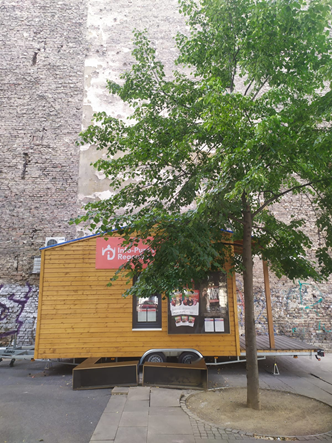Gender and Diversity - Luis Miguel
My colleague Giulia and I were assigned the mission of “Gender and diversity”. From the beginning, we assumed that our walking tour would not be able to capture the issue in its entirety because of the limitations of our own subjective experience – especially for a cisgender man as I am-, but still we decided to wander around the area of Schöneberg Nord. We already knew that this part of the neighbourhood had a strong LGBT community presence, so it seemed like the right way to go in order to build a deeper understanding of diversity in the neighbourhood.
During our walk, the general feeling was of an apparent absence of conflict. Diversity was openly celebrated, and the streets were filled with the particular sense of harmony that Berlin irradiates as soon as it is a sunny. In this context, both Giulia and I focused our attention on trying to identify these expressions of diversity and we came across two interesting examples.
On the one hand, we came across a little cabin in the intersection between Eisenacher Straße and Fuggerstraße, with a sign that read: “Info-Punkt Regenbogenkiez” or translated to English “Rainbow-neighbourhood Infopoint”. As we proceeded to read the written materials on its façade, we realised that this cabin served a variety of purposes. It was simultaneously a tourist information point that provided information regarding night life and historical places for the LGBT community, and an experimental site for conflict resolution regarding violence against the LGBT community through the figure of a “Nachtbürgermeister” or “Mayor of the night”. This place also allowed us to identify one key actor: Mann-O-Meter e.V.

On the other hand, not so much of an example, but more of a trend, we observed a continuous commodification of diversity throughout the neighbourhood. The rainbow flag was used as an attraction for commercial services, stripped down of its meaning in most of the cases -as the rainbow ATM shows. Our walking tour ended with the feeling that Schöneberg is yet another example of how the city of Berlin is commodifying most of its alternative spaces.

The afterwork that Giulia and I did went in different directions given the difficulty to find the time to create a shared outcome from this material. So, I decided to expand the lenses through which we were looking at the city with the definition of “Possible City” since the connection with “Heritage and the Commons” seemed immediate to me. Utopian and radical traditions represent an interesting way to understand the conflicts and potentialities of the present, especially in a context with such a pioneer LGBT community as Schöneberg.
The objective of this was twofold. On the one hand I intended to trace back terrains of struggle of relevant actors, as well as utopian visions of the past, and on the other hand to identify commonalities with the present and room for transformative action. Based on our walking tour we could see that the commodification of leisure could potentially be a terrain of struggle, and this thought was supported as well by a consultation process of 2019 that identified “non-commercial meeting places for all” as a key demand of the citizens’ of the area (1).
With this mind I submerged into the history of these movements with the intention to find non-commodified imaginaries that would shed light into the inquiry. This led to identify actors like Mann-O-Meter e.V (1986) or AHA e.V (1976) that were key in the promotion of the non-commercial gay scene in Berlin; and Potse (1980) and Drugstore (1972), which were also key in the promotion of free culture (although not exclusively LGBT). However, the richness in the history of the movements in this area soon proved to be overwhelming and it became obvious that the next steps were beyond the phase of reconnaissance.
A couple directions crossed my mind as how the inquiry should continue, but it all came to the point of establishing contact with these local actors, who are undeniable recipients of the historical struggle of the neighbourhood, and to find what kind of outcome could be meaningful in this context.
(1) https://www.berlin.de/ba-tempelhof-schoeneberg/politik-und-verwaltung/gremien-und-ansprechpersonen/buerger-innenrat/schoeneberg-nord/artikel.851356.php